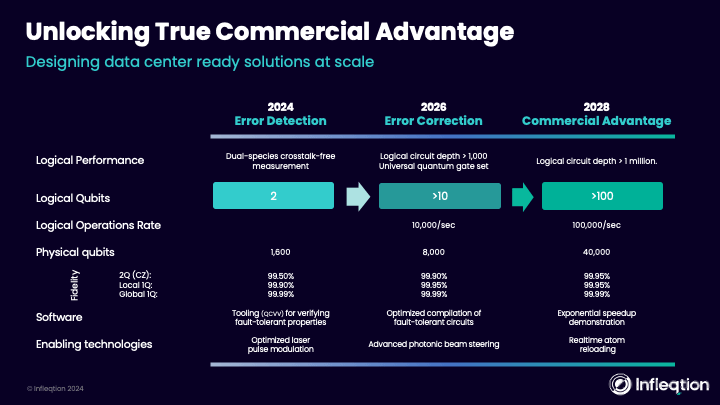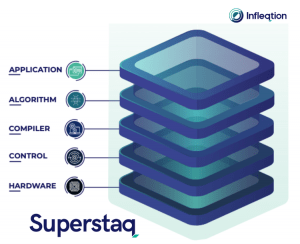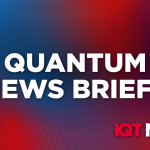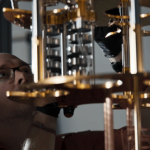News From Infleqtion: Inertial Sensors, Atomic Clocks, RF Receivers… oh, and 1,600 Qubits: by Brian Siegelwax

On February 8, 2024, Infleqtion held its inaugural webinar titled “Infleqtion’s Quantum Blueprint: Quantum Solutions for 2024 and Beyond.” Before recapping the roadmap forward, it’s worth noting that Infleqtion has been in the news a lot in recent months.
Reflection on Infleqtion: The Past 5 Months

The Superstaq by Infleqtion offered a new way to accelerate quantum computing. (PC Infleqtion)
First, on September 12, 2023, Infleqtion announced the open beta of Superstaq, its flagship software that optimizes each layer of the software stack for “accelerating quantum computing performance.” Then on November 2, 2023, Infleqtion showcased its Tiqker commercial atomic clock at the UK National Quantum Technologies Showcase 2023. Then on December 5, 2023, Infleqtion announced the launch of its Oqtant QMS [Quantum Matter Service] to “enable new quantum discoveries, product development and technology innovation through an easily accessible cloud platform.” Then on December 7, 2023, Infleqtion presented Q-CHOP (Quantum-Constrained Hamiltonian Optimization) for optimizing ETF arbitrage at Q2B 2023 Silicon Valley. Then on December 12, 2023, Infleqtion announced its selection into Japan’s Quantum Moonshot Program, which intends to develop a large-scale, high-fidelity neutral atom quantum computer. Then on January 29, 2024, Infleqtion announced the acquisition of two integrated silicon photonics companies, SiNoptiq Inc. and Morton Photonics Inc., to “[accelerate] commercialization of quantum products at scale.” Then on January 30-31, 2024, at SPIE Photonics West, Infleqtion unveiled its desqtopMOT benchtop cold atom platform and presented an optical lattice atom interferometer designed with machine learning. And then on February 5, 2024, Infleqtion announced it will be collaborating on a neutral atom quantum computing testbed for the UK’s National Quantum Computing Center (NQCC).
Infleqtion has seemingly made more substantive announcements in more areas in the past five months
than any other quantum technology company has made in the past five years.
The Next 5 Years: Quantum Leapfrogging the Industry
Building on 16 years of neutral atom technology experience with lasers, atomic prisms, and quantum software, Infleqtion announced its product focus on inertial sensors, atomic clocks, radio frequency receivers, and quantum computing. The star of the webinar was Sqorpius and Infleqtion’s five-year quantum computer roadmap. With 1,600 neutral Cesium atom qubits in a 40×40 array, Sqorpius leapfrogs all other existing quantum computers in qubit count. The goal is over 100 error-corrected fault-tolerant qubits (40,000 atoms) executing over 100,000 operations per second at 99.95% fidelity in 2028. Using dual species (Rb, Cs) of atoms will minimize crosstalk. And with Superstaq, their goal is to enable logical circuit depths exceeding 1 million. During the Q&A, it was revealed that Sqorpius is scalable to tens of thousands of qubits before interconnects will be needed.
Additional announcements included: 1) Superstaq will enable access to its
Supercheq protocol and Oxford Quantum Computing’s (OQC) 32-qubit “Toshiko” superconducting quantum computer at Defence Cyber Marvel 3 (DCM3), an annual competition in which teams of participants try to stop realistic potential cyberattacks, 2) the alpha launch of their open source qLDPC software library, which is a set of “tools for constructing and analyzing quantum low density partity check (qLDPC) codes,” and 3) a Memorandum of Understanding (MOU) with Texas A&M University and the Texas A&M. Semiconductor Institute to develop a quantum test range to support the development of “next-generation quantum technologies and products, including quantum applications for scaling artificial intelligence (AI) using quantum.”
They also announced that Tiqker Prime, a 3U rack-mounted system with applications in “smart grids, timing services, wireless broadband, financial timestamping, network synchronization, scientific test and measurement, radio astronomy, autonomous vehicles, sensor networks, GPS ground services, and national timekeeping” is available for pre-order. Early models are already in use in some datacenters.
Finally, they recapped the aforementioned NQCC initiative, mentioned advancements in “contextual
AI/ML,” and teased a product called eXaqt. Although eXaqt wasn’t discussed, the slide indicated that is a rugged, deployable system for PNT (precision, navigation, timing) and gravitational sensing.
The Next Showcase: SqyWire
Next up, Infleqtion will be showcasing SqyWire on February 14-16 at booth 109 of the AFA Warfare Symposium at the Gaylord Rockies Resort & Convention Center in Denver. SqyWire is a compact, portable, ultra-broadband, radio frequency (RF) receiver that builds on Infleqtion’s 7 years of experience in Rydberg (excited state) atom-based RF sensing, which has included collaborations with AFRL Radars, DARPA Savant, DARPA Quantum Apertures, and NASA QUARREM. After 12 months in development, the SqyWire Quantum Radio Frequency (QRF) aperture/receiver system, which interoperates with Electronic Warfare (EW) and PRC-138B handheld Single Channel Ground and Airborne Radio System (SINCGARS) systems, was successfully demonstrated in the HL to L-band frequency range at Army C5ISR NetModX23.
The benefits of SqyWire to communication and sensing include ultra-wideband frequency coverage,
increased sensitivity, greater range, longer battery life, more signal processing power, and compact size with no antennas and no solid-state analog receivers. Because it uses atoms instead of an antenna, it is naturally robust against jamming. It replaces multiple legacy technologies and solves some spectrum problems in current RF networks.
If you’re unable to attend the AFA Warfare Symposium, the December 5-7 Q2B23 SV presentation
“Quantum Radio Frequency Sensing” by Dr. William Clark and Chris Dorny is online.
Final Thoughts on Infleqtion
If any other company hosted this webinar, this article would be dominated by “1,600 qubits” and a five-year roadmap to over 100 error-corrected fault-tolerant qubits. But because this webinar was hosted byInfleqtion, Sqorpius consumes only one paragraph out of an article that weighs in at just under 1,000 words. It is a testament to the company’s activity level that Sqorpius needs to share a headline. If you missed this webinar and would like to catch the next one, Infleqtion will be hosting webinars on Superstaq on March 21, Security/Defense/Aerospace on April 10, and enterprise applications on May 8.
All images are used with permission from https://www.infleqtion.com/.
Brian N. Siegelwax is an independent Quantum Algorithm Designer and a freelance writer for Inside Quantum Technology. He is known for his contributions to the field of quantum computing, particularly in the design of quantum algorithms. He has evaluated numerous quantum computing frameworks, platforms, and utilities and has shared his insights and findings through his writings. Siegelwax is also an author and has written books such as “Dungeons & Qubits” and “Choose Your Own Quantum Adventure”. He regularly writes on Medium about various topics related to quantum computing. His work includes practical applications of quantum computing, reviews of quantum computing products, and discussions on quantum computing concepts.





















